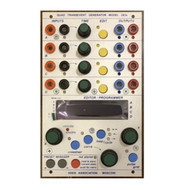Keen Association - Buchla 282e
by Robert Standefer
When a new Buchla-format module emerges from a third-party manufacturer, in this case Keen Association, it's exciting. Upon seeing a picture of the Quad Transevent Generator Model 282e, I had no idea what it did, but I knew I had to have it. I'm so glad I pulled the trigger, because the 282e is extremely powerful, it fits perfectly into the Buchla paradigm, and it is rare, with only about 20 originals being produced by Buchla back in the 70s.
In simple terms, The Quad Transevent Generator Model 282e is a control voltage source. Inspired by the classic Multiple Arbitrary Function Generator Model 248 (the MARF) I think it could be best compared to the Rossum Electro-Music Control Forge. The 282e has four independent sections, each of which offers a multi-segment continuous control voltage series, or "transevent." The 282e interface provides controls and a display to allow you to use an Etch-a-Sketch approach to define a transevent on a Cartesian plane, using an "X" knob and a "Y" knob to draw a shape. The X axis has a time dimension, from .10 seconds to 17 minutes and the Y axis has 255 points of resolution which allows you to draw a shape on the graph, intersecting at different points. A vertical line moves through the transevent and outputs the control voltages that are defined in the series in one of three directions: forward, backward, or ping-pong. The 282e also has a pulse grid that allows you to create a pulse anywhere in the series, and as the 282e moves through the transevent, it will fire a pulse at any point where one is defined.
With the 282e you can create all kinds of interesting and complex functions which you can use as envelopes, LFOs, and much more, though despite its CV shaping and pulse outputs, it is not really intended for making sequences. Unlike envelope generators, which produce specific transient functions (like ADSR), the 282e allows you to create arbitrary transient functions that are much more expressive and give you more dynamic control over modulation.
The UX of the 282e panel is laid out well and easy to use. Each section has a pulse input for start/stop, a CV input for modulating the time, a CV output, a pulse output, and an Edit button. There's an "Editor/Programmer" window that is shared by all four sections. Pressing the Edit button for a section displays its transevent in the Editor/Programmer window, where you can use the X and Y knobs to set the parameters of the series. The "Curve" button simplifies drawing a curve through a defined area of the series, rather than requiring you to meticulously use the X and Y buttons. If you've ever drawn a curve on a Etch-a-Sketch, you'll appreciate the Curve button.
When I got the 282e, I enjoyed drawing different shapes and sending the CV to all kinds of different inputs, like Timbre on the 261e Complex Waveform Generator to modulate the waveshape. The 282e rewards exploration and the graphic display helps with using one's imagination. Modulating the time series of the function makes for some really expressive control voltages. For example, turning off cycling and sending a pulse at the end of each section to start the section that follows will result in a pretty crazy envelope.
The 282e is the first third-party module to offer a preset manager, a feature which had previously only been available in two Buchla modules [the 206e Mixer, and the 225e MIDI Decoder]. The preset manager in the 282e is simple to use and offers a grid of preset locations which you can select with the encoder, as well as a forward and back button to move through the presets. It doesn't have naming or control voltage addressing of presets, which is a limitation that can be frustrating in live performances, however, the preset manager has the unique feature of being able to turn off "Remote Enable" for all modules, disconnecting them from the preset system, so that you can easily switch presets for specific modules in a live performance. One other quibble with the preset manager is that it locks up with some modules that Keen Association were unable to test, including the Polyphonic Rhythm Generator Model 252e and the Duophonic Pitch Class Generator Model 260e. Fortunately, the preset manager can be easily turned off with a switch on the back.
The 282e is an innovative use of the Arduino platform to provide a powerful, expressive, upgradeable, and fun module, without feeling like it's a computer. It rewards exploration and the graphic display really helps with using one's imagination, though at the same time it benefits from understanding what you want to happen and how it fits into one's own Buchla instrument. In the absence of a modern, e-series MARF 248, the 282e does an excellent job of providing an extensive degree of control over the dynamic aspect of one’s music, and has thus become a cornerstone in my Buchla modular instrument.
Price: $1,700


